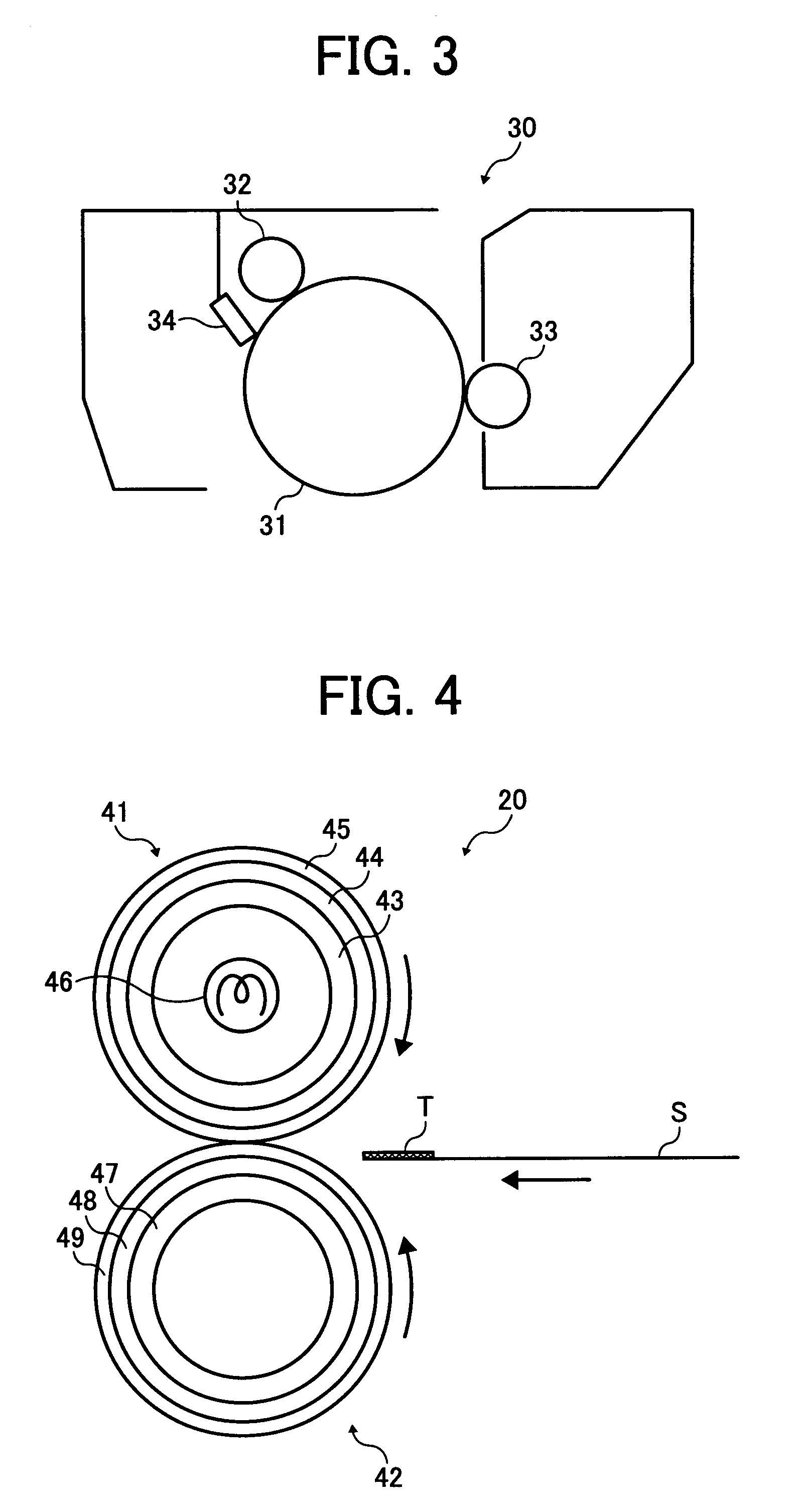Toner for developing electrostatic image, and developer, toner container, image forming apparatus and process cartridge using the toner
a technology for developing electrostatic images and toner containers, which is applied in the field of toner, can solve the problems of deterioration of blocked toners, and hardly improved or rather deteriorated high temperature preservability of toners
- Summary
- Abstract
- Description
- Claims
- Application Information
AI Technical Summary
Problems solved by technology
Method used
Image
Examples
example 1
Preparation of Colorant / Wax Dispersion (Oil Phase Liquid)
[0246]In a reaction vessel equipped with a stirrer and a thermometer, 126 parts of the polyester resin 1, 42 parts of a paraffin wax having a melting point of 72° C., and 438 parts of ethyl acetate were mixed and the mixture was heated to 80° C. while agitated. After the mixture was heated at 80° C. for hours, the mixture was cooled to 30° C. over 1 hour. Then 137 parts of the master batch 1 was added thereto, and the mixture was agitated for 1 hour.
[0247]Then the mixture was contained in another container, and subjected to a dispersion treatment using a bead mill (ULTRAVISCOMILL from Aimex Co., Ltd.). The dispersing conditions were as follows.
[0248]Liquid feeding speed: 1 kg / hour
[0249]Peripheral speed of disc: 6 m / sec
[0250]Dispersion media: zirconia beads with a diameter of 0.5 mm
[0251]Filling factor of beads: 80% by volume
[0252]Repeat number of dispersing operation: 3 times (3 passes)
[0253]Thus, a raw material dispersion 1 w...
example 2
Preparation of Colorant / Wax Dispersion
[0269]The following components were mixed and agitated for 2 hours with a stirrer to prepare a colorant / wax dispersion 2.
Raw material dispersion prepared in Example 1372 partsEthyl acetate solution of polyester resin 1242 parts(solid content of 70%)
[0270]Then ethyl acetate was added thereto so that the solid content of the colorant / wax dispersion 2 is 50% by weight when the solid content is determined by drying the dispersion for 30 minutes at 130° C.
Preparation of Aqueous Phase Liquid
[0271]The aqueous phase liquid 1 prepared in Example 1 was used.
Emulsification and Solvent Removal
[0272]Then the following components were fed into a vessel.
Colorant / wax dispersion (2) prepared above 644 partsIsophorondiamine 0.5 parts
[0273]The components were mixed for 1 minute by a TK HOMOMIXER from Tokushu Kika Kogyo K.K. rotated at a revolution of 5,000 rpm.
[0274]Then 1340 parts of the aqueous phase liquid 1 was added thereto, and the mixture was mixed for 20 m...
example 3
Preparation of Colorant / Wax Dispersion
[0279]The following components were mixed and agitated for 2 hours with a stirrer to prepare a colorant / wax dispersion 3.
Raw material dispersion prepared in Example 1372 partsEthyl acetate solution of polyester resin 1303 parts(solid content of 70%)
[0280]Then ethyl acetate was added thereto so that the solid content of the colorant / wax dispersion 3 is 50% by weight when the solid content is determined by drying the dispersion for 30 minutes at 130° C.
Preparation of Aqueous Phase Liquid
[0281]The aqueous phase liquid 1 prepared in Example 1 was used.
Emulsification and Solvent Removal
[0282]Then the following components were fed into a vessel.
Colorant / wax dispersion (3) prepared above 729 partsIsophorondiamine 0.5 parts
[0283]The components were mixed for 1 minute by a TK HOMOMIXER from Tokushu Kika Kogyo K.K. rotated at a revolution of 5,000 rpm.
[0284]Then 1340 parts of the aqueous phase liquid 1 was added thereto, and the mixture was mixed for 20 m...
PUM
 Login to View More
Login to View More Abstract
Description
Claims
Application Information
 Login to View More
Login to View More - R&D
- Intellectual Property
- Life Sciences
- Materials
- Tech Scout
- Unparalleled Data Quality
- Higher Quality Content
- 60% Fewer Hallucinations
Browse by: Latest US Patents, China's latest patents, Technical Efficacy Thesaurus, Application Domain, Technology Topic, Popular Technical Reports.
© 2025 PatSnap. All rights reserved.Legal|Privacy policy|Modern Slavery Act Transparency Statement|Sitemap|About US| Contact US: help@patsnap.com



